《管理学》课程PPT教学课件(Management, 7th Edition)Chapter 08 STRATEGIC MANAGEMENT
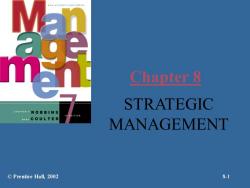
Chapter 8 STRATEGIO ROB B INS COULTER MANAGEMENT ©Prentice Hall,2002 8-1
Chapter 8 STRATEGIC MANAGEMENT © Prentice Hall, 2002 8-1

Learning Objectives You should learn to: Explain the importance of strategic management Describe the steps in the strategic management process Explain SWOT analysis Differentiate corporate-,business-,and functional-level strategies Explain what competitive advantage is and why it's important to organizations ©Prentice Hall,.2002 8-2
Learning Objectives You should learn to: – Explain the importance of strategic management – Describe the steps in the strategic management process – Explain SWOT analysis – Differentiate corporate-, business-, and functional-level strategies – Explain what competitive advantage is and why it’s important to organizations © Prentice Hall, 2002 8-2
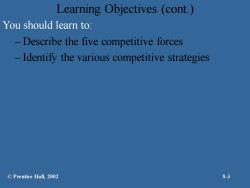
Learning Objectives (cont. You should learn to: -Describe the five competitive forces Identify the various competitive strategies ©Prentice Hall,.2002 8-3
Learning Objectives (cont.) You should learn to: – Describe the five competitive forces – Identify the various competitive strategies © Prentice Hall, 2002 8-3
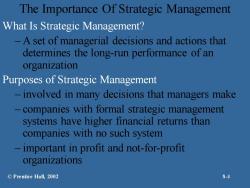
The Importance Of Strategic Management What Is Strategic Management? -A set of managerial decisions and actions that determines the long-run performance of an organization Purposes of Strategic Management - involved in many decisions that managers make companies with formal strategic management systems have higher financial returns than companies with no such system important in profit and not-for-profit organizations ©Prentice Hall,2002 8-4
The Importance Of Strategic Management What Is Strategic Management? – A set of managerial decisions and actions that determines the long-run performance of an organization Purposes of Strategic Management – involved in many decisions that managers make – companies with formal strategic management systems have higher financial returns than companies with no such system – important in profit and not-for-profit organizations © Prentice Hall, 2002 8-4
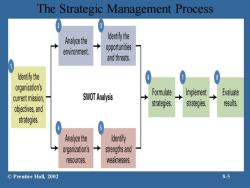
The Strategic Management Process Analyze the deni the environment. oppoitunities and threats. dentifythe organization's SWOTAnalysis Formulate mplement Evaluate current mission, strategs strateg results. biv,and strategis. Analyze the denti organization's → strngand resources. weaknesses. ©Prentice Hall,2002 8-5
The Strategic Management Process © Prentice Hall, 2002 8-5
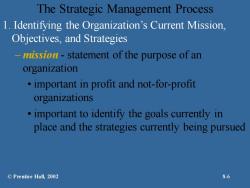
The Strategic Management Process 1.Identifying the Organization's Current Mission, Objectives,and Strategies maission-statement of the purpose of an organization important in profit and not-for-profit organizations important to identify the goals currently in place and the strategies currently being pursued ©Prentice Hall,2002 8-6
The Strategic Management Process 1. Identifying the Organization’s Current Mission, Objectives, and Strategies – mission - statement of the purpose of an organization • important in profit and not-for-profit organizations • important to identify the goals currently in place and the strategies currently being pursued © Prentice Hall, 2002 8-6
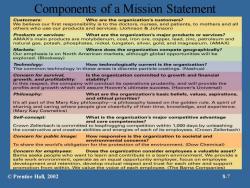
Components of a Mission Statement Customers: Who are the organization's customers? We believe our first responsibility is to the doctors,nurses,and patients,to mothers and all others who use our products and services.(Johnson Johnson) Products or services: What are the organization's major products or services? AMAX's main products are molybdenum,coal,iron ore,copper,lead,zinc,petroleum and natural gas,potash,phosphates,nickel,tungsten,silver,gold,and magnesium.(AMAX) Markets: Where does the organization compete geographically? Our emphasis is on North American markets,although global opportunities will be explored.(Blockway) Technology: How technologically current is the organization? The common technology in these areas is discrete particle coatings.(Nashua) Concern for survival, Is the organization commited to growth and financial growth,and profitability: stability? In this respect,the company will conduct its operations prudently,and will provide the profits and growth which will assure Hoover's ultimate success.(Hoover's Universal) Philosophy: What are the organization's basic beliefs,values,aspirations, and ethical priorities? hamngearinwhere popv heyhumenowioge andxpenenco It's all part of the Mary Kay philosophy- (Mary Kay Cosmetics)】 Self-concept: What is the organization's major competitive advantage and core competencies? Crown Zellerbach is committed to leapfrogging competition within 1,000 days by unleashing the constructive and creative abilities and energies of each of its employees.(Crown Zellerbach) Concern for public image: How responsive is the organization to societal and environmental concerns? To share the world's obligation for the protection of the environment.(Dow Chemical) Concern for employees: Does the organization consider employees a valuable asset? Bama seeks people who want to learn and contribute in a team environment.We provide a safe work environment,operate as an equal opportunity employer,focus on employee development and retention,develop mutual respect and trust for each other and support promotion from within.We value the voice of each employee.(The Bama Companies) ©Prentice Hall,2002 8-7
Components of a Mission Statement © Prentice Hall, 2002 8-7
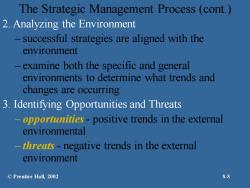
The Strategic Management Process (cont.) 2.Analyzing the Environment successful strategies are aligned with the environment examine both the specific and general environments to determine what trends and changes are occurring 3.Identifying Opportunities and Threats opportities-positive trends in the external environmental dbreaky-negative trends in the external environment ©Prentice Hall,.2002 8-8
The Strategic Management Process (cont.) 2. Analyzing the Environment – successful strategies are aligned with the environment – examine both the specific and general environments to determine what trends and changes are occurring 3. Identifying Opportunities and Threats – opportunities- positive trends in the external environmental – threats - negative trends in the external environment © Prentice Hall, 2002 8-8
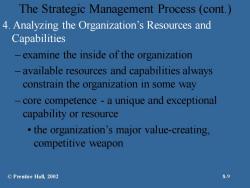
The Strategic Management Process (cont. 4.Analyzing the Organization's Resources and Capabilities examine the inside of the organization -available resources and capabilities always constrain the organization in some way -core competence -a unique and exceptional capability or resource the organization's major value-creating, competitive weapon ©Prentice Hall,2002 8-9
The Strategic Management Process (cont.) 4. Analyzing the Organization’s Resources and Capabilities – examine the inside of the organization – available resources and capabilities always constrain the organization in some way – core competence - a unique and exceptional capability or resource • the organization’s major value-creating, competitive weapon © Prentice Hall, 2002 8-9
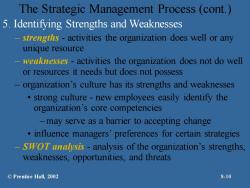
The Strategic Management Process (cont.) 5.Identifying Strengths and Weaknesses strengdbs-activities the organization does well or any unique resource weaknesses-activities the organization does not do well or resources it needs but does not possess organization's culture has its strengths and weaknesses strong culture-new employees easily identify the organization's core competencies may serve as a barrier to accepting change - influence managers'preferences for certain strategies -SWOT analiysis-analysis of the organization's strengths, weaknesses,opportunities,and threats ©Prentice Hall,.2002 8-10
The Strategic Management Process (cont.) 5. Identifying Strengths and Weaknesses – strengths - activities the organization does well or any unique resource – weaknesses - activities the organization does not do well or resources it needs but does not possess – organization’s culture has its strengths and weaknesses • strong culture - new employees easily identify the organization’s core competencies –may serve as a barrier to accepting change • influence managers’ preferences for certain strategies – SWOT analysis - analysis of the organization’s strengths, weaknesses, opportunities, and threats © Prentice Hall, 2002 8-10
按次数下载不扣除下载券;
注册用户24小时内重复下载只扣除一次;
顺序:VIP每日次数-->可用次数-->下载券;
- 《管理学》课程PPT教学课件(Management, 7th Edition)Chapter 07 FOUNDATIONS OF PLANNING.ppt
- 《管理学》课程PPT教学课件(Management, 7th Edition)Chapter 06 DECISION MAKING:THE ESSENCE OF THE MANAGER’S JOB.ppt
- 《管理学》课程教学资源(课件讲义)Stephen P.Robbins(9)Chapter 2 Management Yesterday and Today.pdf
- 《管理学》课程教学资源(课件讲义)Stephen P.Robbins(9)Chapter 1 Introduction to Management and Organizations.pdf
- 《管理学》课程教学资源(教师手册)Stephen P.Robbins(9)CHAPTER TWO Management Yesterday.pdf
- 《管理学》课程教学资源(教师手册)Stephen P.Robbins(9)CHAPTER ONE Introduction to Management.pdf
- 《管理学》课程PPT教学课件(Management)Stephen P.Robbins(9)第十二章 人力资源管理 Human Resource Management.ppt
- 《管理学》课程PPT教学课件(Management)Stephen P.Robbins(9)第十章 组织结构与设计 Organizational Structure and Design.ppt
- 《管理学》课程PPT教学课件(Management)Stephen P.Robbins(9)第十五章 理解群体与团队 Understanding Groups and Teams.ppt
- 《管理学》课程PPT教学课件(Management)Stephen P.Robbins(9)第十九章 运营及价值链管理 Operations and Value Chain Management.ppt
- 《管理学》课程PPT教学课件(Management)Stephen P.Robbins(9)第三章 组织文化与环境——约束力量 Organizational Culture and Environment - The Constraints.ppt
- 《管理学》课程PPT教学课件(Management)Stephen P.Robbins(9)第二章 管理的昨天和今天 Management Yesterday and Today.ppt
- 《管理学》课程PPT教学课件(Management)Stephen P.Robbins(9)第五章 社会责任与道德管理 Social Responsibility and Managerial Ethics.ppt
- 《管理学》课程PPT教学课件(Management)Stephen P.Robbins(9)第四章 全球环境中的管理 Managing in a Global Environment.ppt
- 《管理学》课程PPT教学课件(Management)Stephen P.Robbins(9)第六章 制定决策——管理者工作的实质 Decision-Making - The Essence of the Manager’s Job.ppt
- 《管理学》课程PPT教学课件(Management)Stephen P.Robbins(9)第八章 战略管理 Strategic Management.ppt
- 《管理学》课程PPT教学课件(Management)Stephen P.Robbins(9)第十六章 激励员工 Motivating Employees.ppt
- 《管理学》课程PPT教学课件(Management)Stephen P.Robbins(9)第十一章 管理沟通与信息技术 Communication and Information Technology.ppt
- 《管理学》课程PPT教学课件(Management)Stephen P.Robbins(9)第一章 管理与组织导论 Introduction to Management and Organizations.ppt
- 《管理学》课程PPT教学课件(Management)Stephen P.Robbins(9)第七章 计划的基础 Foundations of Planning.ppt
- 《管理学》课程PPT教学课件(Management, 7th Edition)Chapter 09 PLANNING TOOLS AND TECHNIQUES.ppt
- 《管理学》课程PPT教学课件(Management, 7th Edition)Chapter 10 ORGANIZATIONAL STRUCTURE AND DESIGN.ppt
- 《管理学》课程PPT教学课件(Management, 7th Edition)Chapter 11 MANAGERIAL COMMUNICATION AND INFORMATION TECHNOLOGY.ppt
- 《管理学》课程PPT教学课件(Management, 7th Edition)Chapter 12 HUMAN RESOURCE MANAGEMENT(HRM).ppt
- 《管理学》课程PPT教学课件(Management, 7th Edition)Chapter 13 MANAGING CHANGE AND INNOVATION.ppt
- 《管理学》课程PPT教学课件(Management, 7th Edition)Chapter 14 FOUNDATIONS OF BEHAVIOR.ppt
- 《管理学》课程PPT教学课件(Management, 7th Edition)Chapter 15 UNDERSTANDING GROUPS AND TEAMS.ppt
- 《管理学》课程PPT教学课件(Management, 7th Edition)Chapter 16 MOTIVATING EMPLOYEES.ppt
- 《管理学》课程PPT教学课件(Management, 7th Edition)Chapter 18 FOUNDATIONS OF CONTROL.ppt
- 《管理学》课程PPT教学课件(Management, 7th Edition)Chapter 19 OPERATIONS AND VALUE CHAIN MANAGEMENT.ppt
- 《管理学》课程PPT教学课件(Management, 7th Edition)Chapter 20 CONTROLLING FOR ORGANIZATIONAL PERFORMANCE.ppt
- 《管理学》课程教学资源(实验讲义)企业竞争模拟攻略篇.pdf
- 《管理学》课程教学资源(习题与答案)第1章 管理活动与管理理论.doc
- 《管理学》课程教学资源(习题与答案)第3章 全球化与管理.doc
- 《管理学》课程教学资源(习题与答案)第6章 计划与计划工作.doc
- 《管理学》课程教学资源(习题与答案)第十章 组织变革与组织文化.doc
- 《管理学》课程教学资源(习题与答案)第16章 管理的创新职能.doc
- 《管理学》课程教学资源(习题与答案)第1章 管理活动与管理理论.doc
- 《管理学》课程教学资源(习题与答案)第3章 全球化与管理.doc
- 《管理学》课程教学资源(习题与答案)第4章 信息与信息化管理.doc
